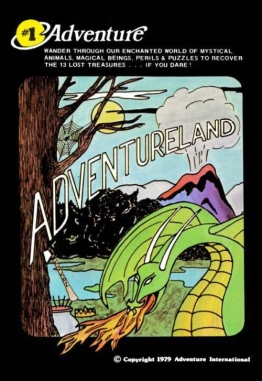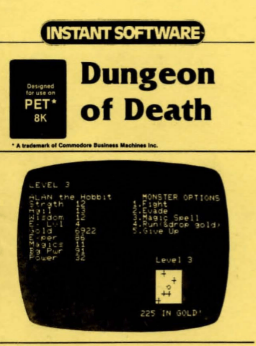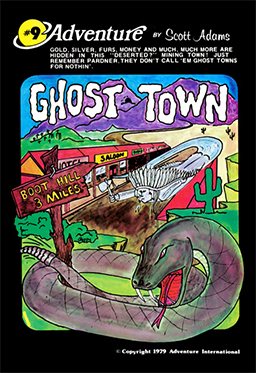Strange Odyssey is a text adventure written by Scott Adams and Neil Broome.
Strange Odyssey is a text adventure written by Scott Adams and Neil Broome.
Published by Adventure International, this text-based adventure game was one of many from Scott Adams.
Gameplay involved moving from location to location, picking up any objects found there, and using them somewhere else to unlock puzzles. Commands took the form of verb and noun, e.g. "Take Shovel". Movement from location to location was limited to North, South, East, West, Up, and Down.
The game begins with the player stranded on a tiny asteroid in a damaged spaceship. The player must use an alien teleportation device to travel to distant worlds, collect treasure, and find the materials to repair the spacecraft.
Kilobaud Microcomputing stated that Strange Odyssey was inferior in quality to Adventureland despite being released later, stating that the older game had "many more treasures and situations to figure out" and criticizing Strange Odyssey's lack of help for novice players. [1] The game was reviewed in issue #42 of The Dragon magazine. The reviewer, Mark Herro, stated that "My present situation in this game is opposite that of Pirate Adventure . I’ve found treasures but I don’t know where to take them! ... The game starts in the control room of a disabled spaceship. It took me a good half hour just to find my way out of the spaceship! To compound problems, a space suit must be worn when outside the spaceship. When the air is gone, that’s it, my friend." [2]

Zork is a text adventure game first released in 1977 by developers Tim Anderson, Marc Blank, Bruce Daniels, and Dave Lebling for the PDP-10 mainframe computer. The original developers and others, as the company Infocom, expanded and split the game into three titles—Zork I: The Great Underground Empire, Zork II: The Wizard of Frobozz, and Zork III: The Dungeon Master—which were released commercially for a range of personal computers beginning in 1980. In Zork, the player explores the abandoned Great Underground Empire in search of treasure. The player moves between the game's hundreds of locations and interacts with objects by typing commands in natural language that the game interprets. The program acts as a narrator, describing the player's location and the results of the player's commands. It has been described as the most famous piece of interactive fiction.

Pool of Radiance is a role-playing video game developed and published by Strategic Simulations, Inc (SSI) in 1988. It was the first adaptation of TSR's Advanced Dungeons & Dragons (AD&D) fantasy role-playing game for home computers, becoming the first episode in a four-part series of D&D computer adventure games. The other games in the "Gold Box" series used the game engine pioneered in Pool of Radiance, as did later D&D titles such as the Neverwinter Nights online game. Pool of Radiance takes place in the Forgotten Realms fantasy setting, with the action centered in and around the port city of Phlan.

Temple of Apshai is a dungeon crawl role-playing video game developed and published by Automated Simulations in 1979. Originating on the TRS-80 and Commodore PET, it was followed by several updated versions for other computers between 1980 and 1986.

The Pawn is an interactive fiction game for the Sinclair QL written by Rob Steggles of Magnetic Scrolls and published by Sinclair Research in 1985. In 1986, graphics were added and the game was released for additional home computers by Rainbird.

Questprobe: Featuring Spider-Man is the second video game in the Questprobe series.

Labyrinth: The Computer Game is a 1986 graphic adventure game developed by Lucasfilm Games and published by Activision. Based on the fantasy film Labyrinth, it tasks the player with navigating a maze while solving puzzles and evading dangers. The player's goal is to find and defeat the main antagonist, Jareth, within 13 real-time hours. Unlike other adventure games of the period, Labyrinth does not feature a command-line interface. Instead, the player uses two scrolling "word wheel" menus on the screen to construct basic sentences.

Hillsfar is a role-playing video game for MS-DOS compatible operating systems, Amiga, Atari ST, and Commodore 64. It was developed by Westwood Associates and published by Strategic Simulations in 1989. It combines real-time action with randomly generated quests and includes elements of the Advanced Dungeons & Dragons fantasy role-playing game. A port to the Nintendo Entertainment System was released in 1993. Hillsfar received mixed reviews from critics.

Space Quest: Chapter I – The Sarien Encounter is a graphic adventure game, created by Scott Murphy and Mark Crowe, and released in October 1986 by Sierra On-Line. It is the first game in the Space Quest series, and sees players assume the role of a lowly janitor on a research ship, who becomes involved in stopping an alien race using a new form of technology for evil purposes.

Adventureland is a text adventure video game for microcomputers, released by Scott Adams in 1978. The game has no plot but simply involves searching for thirteen lost artifacts in a fantasy setting. Its success led Adams to form Adventure International, which went on to publish thirteen similar games in the Adventure series, each in different settings.

Voodoo Castle is a text adventure and is the fourth in the series of adventure games designed by Scott Adams. The game was written by his wife Alexis Adams. The game was published by Adventure International in 1979. It was available for the VIC-20, the Commodore 64, Apple II, and other contemporary computers.

Pirate Adventure is a text adventure video game written by Scott Adams. It was published by Adam's company, Adventure International, in 1979.

Lords of Karma is a text adventure that was produced by Avalon Hill in 1980. It was released for the Apple II, Commodore PET, Atari 8-bit computers, TRS-80, and Commodore 64.

Questprobe featuring The Hulk is a 1984 graphic adventure video game developed and published by Adventure International in collaboration with Marvel Comics. It is the first entry in Questprobe, an intended series of graphic adventure games that only released three installments before the developer's bankruptcy. The game's narrative follows the Marvel superhero Hulk and his human alter-ego Bruce Banner, who must explore the mysterious lair of the Chief Examiner. The graphics and story outline were created by Marvel artists and writers. Critical reception was generally positive, with much of the praise going to the visuals. Reactions to the gameplay were mixed, especially upon the game's budget re-release, by which time it was considered dated.
Adventure International was an American video game publishing company that existed from 1979 until 1986. It was started by Scott and Alexis Adams. Their games were notable for being the first implementation of the adventure genre to run on a microcomputer system. The adventure game concept originally came from Colossal Cave Adventure which ran strictly on large mainframe systems at the time.

Shadowfire is a video game for the ZX Spectrum and Commodore 64 and later the Amstrad CPC. It was developed by British developer Denton Designs and published by Beyond Software in 1985. The player must direct the Enigma Force to rescue Ambassador Kryxix from the traitor Zoff's flagship before the timer runs out and secret plans for a new type of starship are discovered. Shadowfire was one of the first games to use a menu-and-icon-driven interface. It was well received by reviewers of the time, and followed by a sequel, Enigma Force.

Dungeon of Death is a fantasy role-playing video game developed by Instant Software. The game was released on the 8K Commodore PET.

Time Traveler is a 1980 fantasy text adventure developed by Krell Software. The game was released on the 16K, Level II TRS-80, Apple II, Commodore PET, and Atari 8-bit computers

Ghost Town is a text adventure developed by Adventure International and released in 1980. It is part of the Adventure series of games developed by Scott Adams, preceded by Adventureland, Pirate Adventure, and Strange Odyssey.
Instant Software was a company that produced game, utility, and education software in the late 1970s and early 1980s primarily for the TRS-80 line of home computers. Instant Software was a subsidiary of Kilobaud Microcomputing, headquartered in Peterborough, New Hampshire and run by Wayne Green.